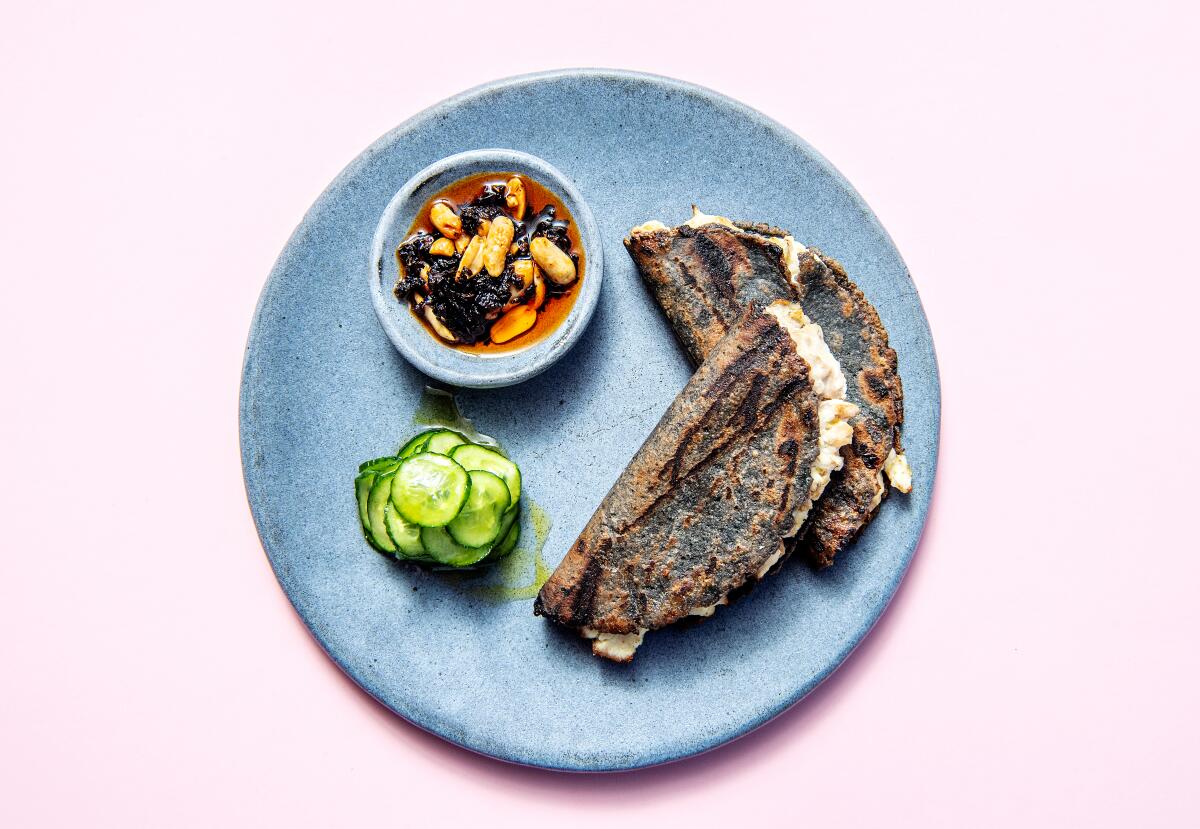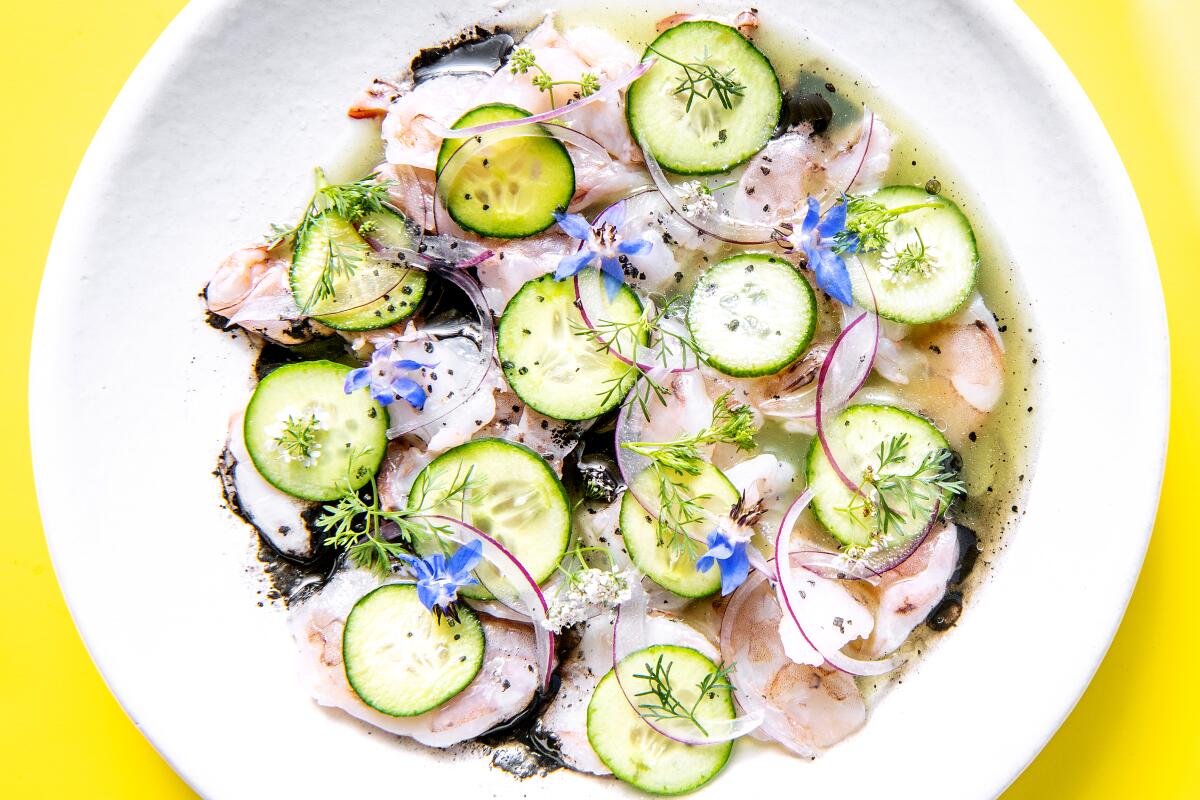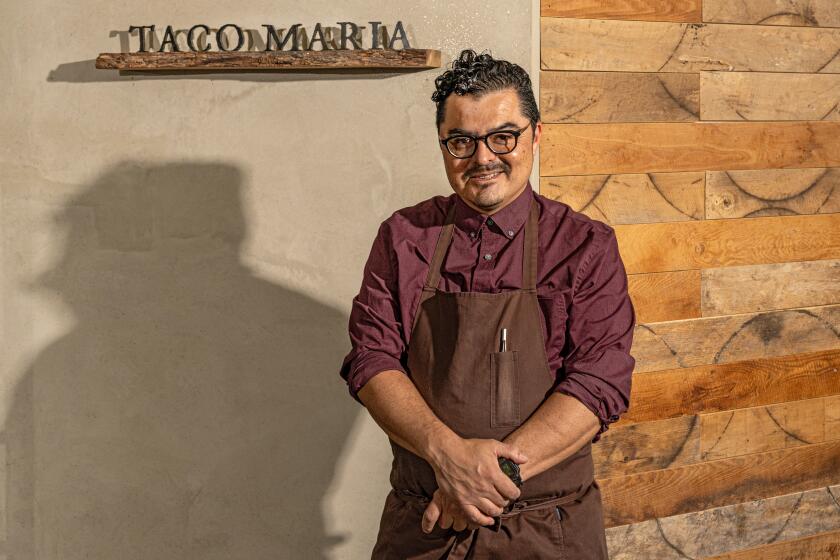Appreciation: Farewell for now, Taco María. We didn’t deserve you

- Share via
When Carlos Salgado returned to his native Orange County from the Bay Area to open a food truck named Taco María, the computer-programmer-turned-pastry-chef immediately gave the world a sense of who he would be: visionary, unapologetically Mexican, and with a wicked sense of humor.
Taco María’s Twitter account stated the truck was named after the matriarchs in Salgado’s family and would focus on “Chicano cuisine.” As food editor for OC Weekly at the time, I found Salgado’s proclamation preposterous.
Who the hell was this newcomer with seemingly no knowledge of Orange County dining to think he could succeed in a region where people still expected their Mexican grub to come on combo plates, ordered in a drive-thru, wrapped around a tortilla, or with views of the Pacific?
I tweeted a snide remark at Taco María’s account that demanded he define what “Chicano cuisine” was. “We have issues” was the response.
I immediately burst out laughing and thought “no se dejà” — Salgado doesn’t back down. He proved me right again and again.
Carlos Salgado and his restaurant Taco María in Costa Mesa had a seminal impact on the SoCal dining scene, bringing heirlooom varieties of Mexican corn to the U.S.
His Taco María quickly made its presence known in Orange County’s luxe lonchera scene with sumptuous takes on burritos, tacos, and aguas frescas. Two years later, Salgado opened a brick-and-mortar in Costa Mesa and ditched his food truck menu for something even better: a wholesale interrogation of what Mexican food and a Mexican chef could be.
I was there on opening night, and he helped to cater my wedding in 2014. My wife and I attended his wedding two years later to playwright Emilie Coulson Salgado, who serves as Taco María’s general manager. Together, we’ve all celebrated either in person or via text every time their restaurant won a new accolade — and there’s been many.
Food & Wine Best New Chef for Salgado in 2015. Best O.C. restaurant for both the Orange County Register and OC Weekly from 2014 to 2017. The Times’ Restaurant of the Year in 2018, when the late Jonathan Gold described Taco María as the place that “propelled California-Mexican cooking into the jet stream of abstracted modernist cuisine.”
The Los Angeles area has seen a number of remarkable restaurants open in the last several years, including spaceship fantasies with no recognizable foodstuffs, sushi bars plucked whole from the better precincts of Tokyo and dining rooms so devoted to local produce that it occasionally seems as if they have massive gardens of their own backing up to the kitchen.
Salgado won the Golden Tortilla in my KCRW Tortilla Tournament in 2019 for his incredible blue corn tortillas — the same year Taco María earned its first Michelin star, which it has maintained every year since. He and contemporaries like Ray Garcia and Wes Avila in Los Angeles showed that Mexican Americans could help elevate Mexican food on a worldwide stage just as well as their peers in Mexico like Enrique Olvera and Gabriela Cámara. But Salgado did his proselytizing in a region — Orange County — where being Mexican has far too long been a cultural crime.
That’s why I’m going to be there this Saturday at Taco María’s final night: to bid farewell to what the restaurant accomplished in its decade and also toast to whatever may come next.
The dish heard ‘round the world
Taco María’s genius was to take classic Mexican dishes and place them in the fine-dining world. Unlike too many Alta California spots, however, Salgado never rejected the working class flavors of the meals he was reimagining. He doubled down on them.

Take his version of aguachile, the famous Sinaloan seafood dish that traditionally sees shrimp or scallop marinated in a chilled, spicy lime juice broth. For years, Salgado offered seasonal takes that included everything from dabs of olive oil to watermelon jam. His touches brought out dimensions in aguachile — sweetness, crispness, smokiness — one never thought possible.
It became the dish heard ‘round the culinary world, as aguachile made appearances at other fine-dining restaurants in Los Angeles and beyond — I remember texting Carlos and Emilie a photo of a white-tablecloth eatery in Louisville one year that bragged about the aguachile on its menu (it wasn’t good, alas).
He never allowed himself to be weighed down by expectations, though. Once aguachile became trendy, Salgado took it off Taco María’s menu. His longtime logo was a take on Mexico’s iconic Secretariat of Economy emblem for exports — a modernist black-and-white Aztec eagle head — that read “Hecho en Orange County” instead of “Hecho en Mexico.” Taco María once offered Cortez the Killer, a triple-patty burger with Spanish cheese and date ketchup, that was both a shoutout to the Neil Young song, an homage to SoCal burger culture, and an indictment of the Spanish conquistador. Those in the know gobbled up his Christmastime strawberry tamales or chicharrones dusted in chile de árbol powder, Salgado’s wink at Flamin’ Hot Cheetos.
Despite all the accolades and imitators, I always felt Salgado was unappreciated by Southern California’s food world. Angelenos didn’t patronize Taco María as much as they should’ve because too many still think Orange County is on the other side of the world and a culinary wasteland save for Little Saigon and maybe Little Arabia. The restaurant’s location — an awkward sliver of a triangle in a formerly hip shopping plaza that’s now eerily desolate — didn’t lend well to the conviviality Salgado strove to create.
And then there was the fact that Salgado was a Mexican in a business that didn’t historically have a place for people like him, in a county where Latinos make up 34% of the population. “Culturally and agriculturally,” Salgado said in a 2016 Times story, “California is Mexico.” Yet still they have little power of any kind.
His liminality brought on petty critiques from all sides. Diners got angry that there were no complimentary chips and salsa, or that his guacamole could come spiked with pomegranate seeds one night, and shiso another. Conservatives didn’t appreciate that “Black Lives Matter” was stenciled on Taco María’s windows in 2020, a slogan most eaters didn’t notice until the third course in his prixe fixe menu, or closed down their dining room in the heavy days of the pandemic unlike Arc, a restaurant steps away from Taco María owned by Newport Beach mayor Noah Blom.
Loyal customers got upset that Salgado stopped lunchtime taco service when he reopened. And too many gatekeepers of mexicanidad found Salgado a fresa (snooty) for charging what they thought were excessive prices — nearly 20 bucks for sturgeon tacos? — while not bothering to realize all those costs went toward paying his employees a living wage and buying products from farmers trying to create more equitable food systems. That’s a far better exemplar of Mexican culture than, well, Flamin’ Hot Cheetos.
We didn’t deserve Salgado and his Taco María — and now, we’re not going to have him for the foreseeable future.
Carlos broke the news to me yesterday over the phone. I congratulated him on the move. He and Emilie are the proud parents of two beautiful kids, and have worked at a breakneck speed during an era of tumult for all of us but especially in the restaurant industry. I told him that no matter Taco María’s future, his legacy is secure.
May more follow in Carlos Salgado’s ways.
More to Read
Eat your way across L.A.
Get our weekly Tasting Notes newsletter for reviews, news and more.
You may occasionally receive promotional content from the Los Angeles Times.












